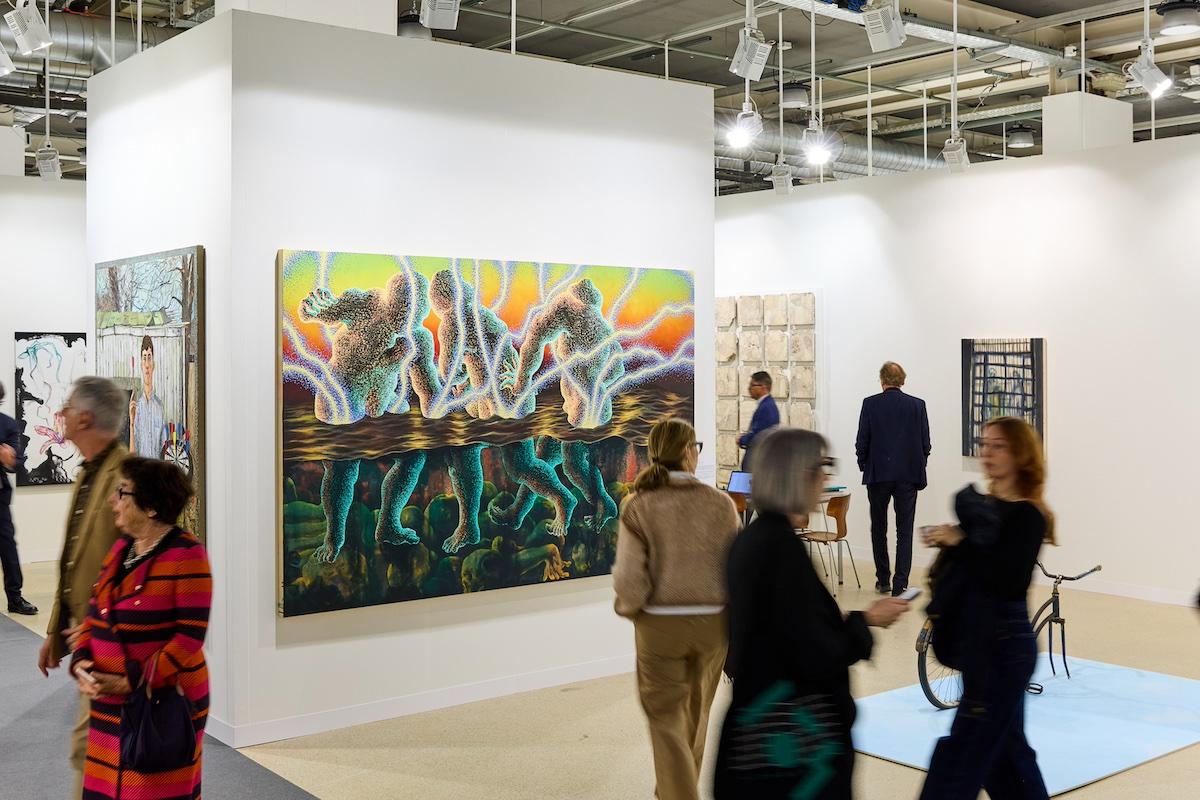
Art Basel in Basel 2024.
The most important art fair worldwide, Art Basel is hosting 285 of the world’s leading galleries from 40 countries and territories in its 2024 edition at the Messe Basel, in the center of a colorful city on the Rhine River in Switzerland.
On view to the public from June 13th to 16th, with VIP preview days on June 11th and 12th, the flagship edition of the famed international fair is divided into several significant sectors. The Unlimited sector occupies the dynamic convention center Hall 1. Galleries, Feature, Statements, and Kabinett sections— along with the Editions, Conversation, and Magazines sectors, and the new Art Basel Shop— are on the first two floors of the nearby Hall 2.
Parcours, a showcase for site-specific public art installations, is centered around the nearby Claraplatz, and Film, a section for art documentaries and innovative works in the medium, takes place at the Stadkino Basel, one of the most significant art-house cinemas in Switzerland.
“For nearly 20 years, I’ve been attending the Art Basel fair. It’s really a magical week, where the best modern and contemporary art is showcased in this temporary museum,” Maike Cruse, Director of Art Basel in Basel, shared with Art & Object on opening day. “The entire international art community comes together to meet, celebrate, gather, and engage in vibrant discussions about art,” she added.
Scroll through to find some of our favorite artworks and gallery presentations at this year’s fair.
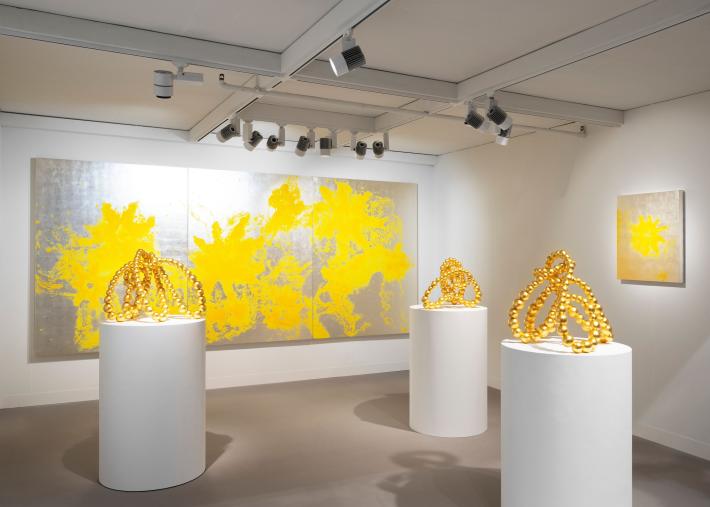
A solo presentation by Jean-Michel Othoniel in the Kabinett sector, Art Basel’s curated selection of installations located within the gallery booths, "Othoniel: Noeuds Sauvages" explores the French artist’s notion of emotional geometry through a group of mirrored glass and sparkling stainless steel sculptures inspired by theories of knots and seductive abstract paintings of symbolic flowers.
The subject of a current retrospective at the Sara Hildén Art Museum in Finland, Othoniel creates spellbinding works of art, which sublimely transport viewers to a serene state of mind.
Image: Jean-Michel Othoniel, Installation view, Othoniel: Noeuds Sauvages, Various media and dimensions, Art Basel Kabinett.
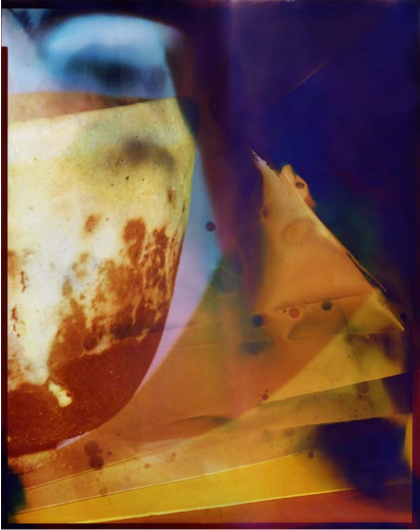
An experimental Portuguese artist best known for his avant-garde photography and film works, João Maria Gusmão has been exploring para-scientific, philosophical, and literary concepts through inventive uses of analog media and immersive cinematic installations for the past 20 years.
Visible at more than one Art Basel booth, Gusmão’s recent series of chemigrams take traditional Japanese-inspired Chawan bowls as the point of departure. Embracing the glazed surfaces of ceramicist Victor Harris’s ceremonial tea cups through the lens of the camera and a colorful chemical mix, the Lisbon-born and based artist creates painterly images in his own sort of photographic kiln— where light becomes fire and his alchemical process the glaze.
Image: João Maria Gusmão, cp92, 2022-23, Fujicolor Crystal Archive RA4 glossy paper, photo reversal chemigram in painted metal frame, 27 3/4 x 21 3/4 in. | 70,5 x 55,2 cm.

A visual prankster who refers to himself as "a sort of neo-conceptualist, Proper-'Gander'-ist, amateur philosopher," Ryan Gander is celebrated internationally for his conceptual artworks, including sculptural installations of animatronic mice that emerge from tiny holes bored into the walls of galleries to deliver philosophical monologues.
His show-stopping "School of Languages" installation at Unlimited is equally compelling with a life-sized, animatronic female gorilla hiding under an office desk while grumbling and counting on her fingers. Meanwhile, a nearby blowing electric fan is dissipating the scent of urine coming from the ape.
What the animal is meant to be conveying is anyone’s guess, but in these surreal times, primitive ways of thinking and acting are the ones that seem to be attracting the most attention.
Image: Ryan Gander, School of languages, 2023. Animatronic gorilla, audio, desk, fan. Installed: 49 1/4 x 133 7/8 x 90 1/2 in | 125 x 340 x 230 cm: Audio: 27:16.
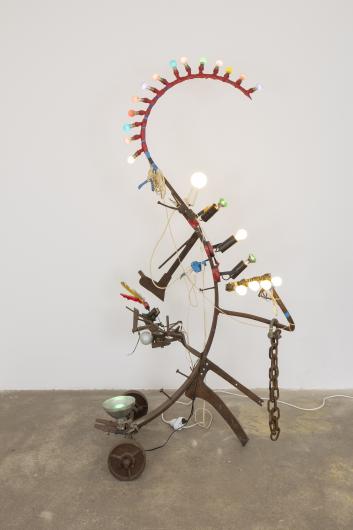
A Swiss sculptor who made kinetic art sculptural machines that satirized automation and the technological production of material goods, Jean Tinguely is best known for his self-destroying sculpture, "Homage to New York," which partially imploded in the garden of New York’s Museum of Modern Art in 1960.
The creator of mechanical fountains that sprayed water in all directions and motorized machines that made nothing more than nonsensical movements, the Neo-Dadaist artist created a number of whimsical lamps cobbled together from discarded metal parts. He made this enchanting one for Jacqueline Matisse, the daughter of another famous modernist artist.
Image: Jean Tinguely, Lampe, c. 1975-1978, Metal, lightbulbs, polyester, feathers, plastic, electrical system. 90 x 46 x 47 in. | 230 x 116 x 120 cm.
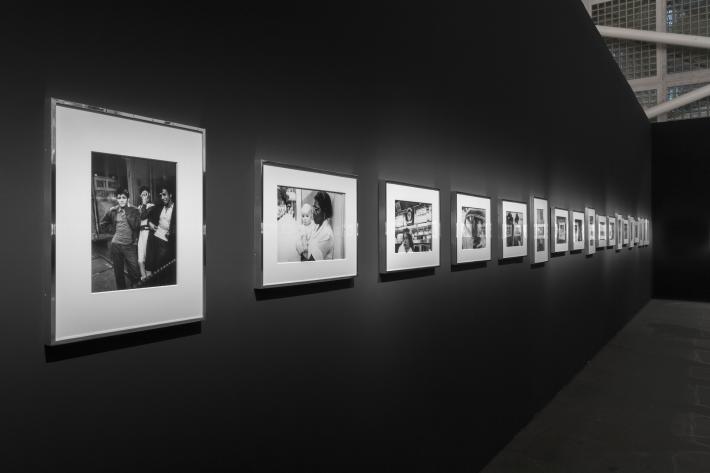
World–renowned for his outsider's view of American society, photographer and filmmaker Robert Frank was born in Switzerland, but made a name for himself with his celebrated 1958 book The Americans.
Working as a photojournalist for New York-based magazines in the 1950s and having his photographs featured in the Museum of Modern Art’s “The Family of Man” exhibition, Frank secured a Guggenheim Fellowship to travel across the United States to photograph all walks of life, with 83 of some 28,000 images forming the book.
Marking the centenary of the artist’s birth, a never-before-exhibited set of images is on view in Unlimited. Retained for his personal collection, the set features an 84th photograph, a triptych image the artist added to the end of the sequence in a 1978 edition of the historic monograph, published by Aperture.
Image: Robert Frank, The Americans, 1954-1957. 84 gelatin silver prints on Agfa paper 12"×16"(30.5cm× 40.6 cm), with each paper signed.
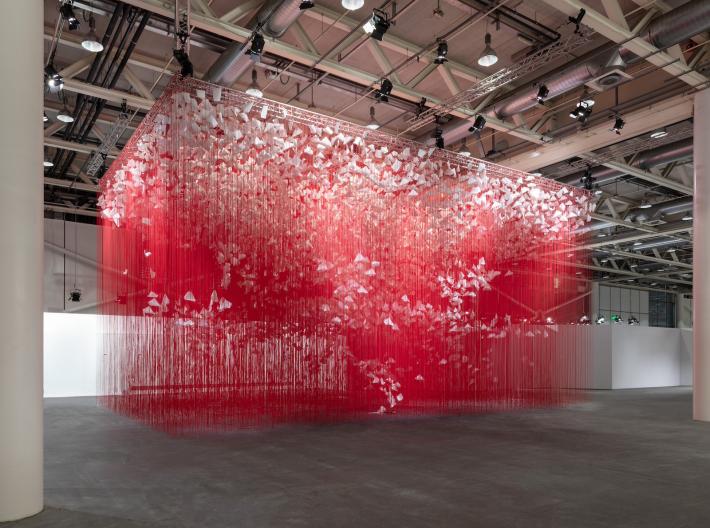
Consisting of hundreds of miles of red ropes suspended above a bronze casting of the artist’s open arms and hands, "The Extended Line" takes its point of departure from Chiharu Shiota’s personal experience as a cancer survivor, but is meant to be a metaphor for the challenges of life that we all face.
The countless sheets of paper attached to the hanging ropes seem to rain down from the heavens like a thunderstorm of concerns, which can only be greeted with openness, understanding, and a will to survive.
"What does it mean to be human?” the Japan-born, Berlin-based artist asks in a floor-label text. “I am asking questions that I believe every person is dealing with during their lifetime and not really getting to a clear conclusion. I believe in the strength of asking those questions together. While we have no answer, we still have the same suffering, regrets, and joys in life.”
Image: Chiharu Shiota, The Extended Line, 2023 - 2024. Mixed media, rope, and paper, 52 x 30 feet | 16 x 9 meters.
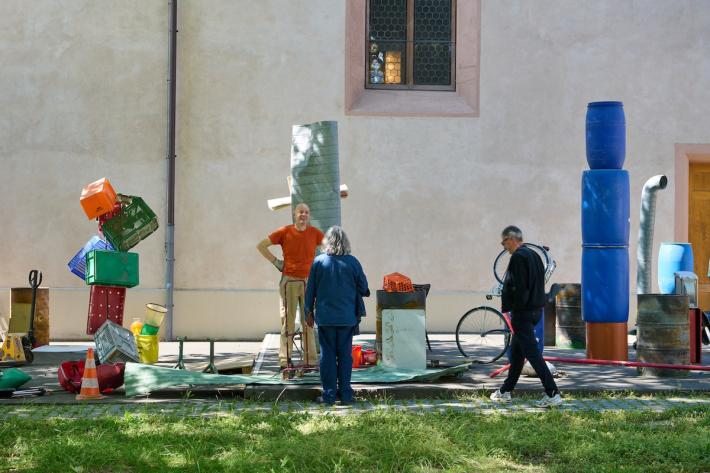
A Swiss-born conceptual artist living and working in Basel, Eric Hattan creates assemblages of found objects in playful, thought-provoking ways. “Stilles Leben a quiet life” is a performative installation where Hattan is continuously assembling and disassembling all types of things from his growing collection of found objects, including old furniture, plastic barrels, broken bicycles, ladders, scrap metal, pieces of wood, and hoses.
Putting a spotlight on the transient nature of urban waste for his Parcours project, Hattan’s work was recently included in a group show about proliferation of environmental pollutants at the Tinguely Museum in Basel. “Stilles Leben a quiet life”— a play on words, as stilles leben means "quiet life" in German, yet sounds like “still living” in English— utilizes disposed installation materials from previous shows at the museum, which is ironically dedicated to an artist who used other people’s trash to make his art.
Image: Eric Hattan, Stilles Leben a quiet life, 2024. Mixed media.
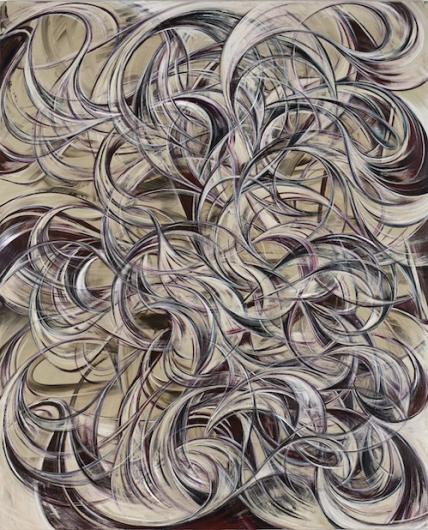
Born in Shenzhen, Yuan Fang journeyed from China to New York to study photography at the School of Visual Arts (SVA), but after turning her photographic images into digital abstractions and mindlessly doodling in class, she shifted her major to painting. And thus, a passion for it quickly developed.
One of the most captivating emerging artists currently working with abstraction, Fang paints layer upon layer of bold swirling brushstrokes to build up compelling compositions that immediately catch the eye and keep it in continuous motion. Starting with looser background marks, including broad brushwork and paint pours, each gestural layer gets tighter, more physically engaging, and more intense.
Fang’s sensual layering of curvilinear forms creates a visual vortex that sucks the viewer into the action— creating a mesmerizing entanglement in the pictorial space, rather than a traditional reading of it. The subject of a sold-out solo show at Skarstedt in London, the young artist— who received her MFA from SVA in 2022— is making her Art Basel debut with “Light Touching,” an energetic painting which joyfully refutes its title.
Image: Yuan Fang, Light Touching, 2024. Acrylic on canvas, 83 x 67 in.
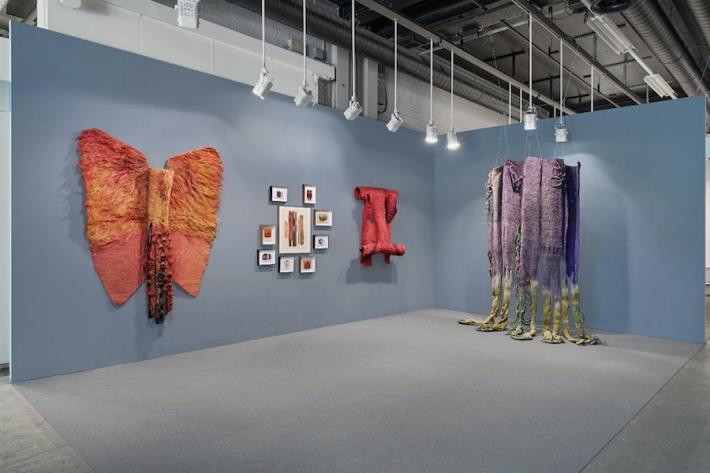
Journeying to China from Bulgaria to study art and art history at the Central Academy of Fine Arts in the 1950s as one of the first foreign exchange students, Maryn Varbanov (1932-1989) met Song Huai-Kuei (1937-2006), a classmate who was assigned to be his translator and guide.
Dating discreetly, the couple married in 1956 and soon became lifelong collaborators as visionary textile artists. Returning to Bulgaria in 1958, Varbanov began working with felt made from goat’s hair to create soft sculptural forms, which would be exhibited as free-standing and suspended column-like forms.
The Bulgarian artist's residency in Paris in 1975 led to shows at the Grand Palais and FIAC and to an introduction to Pierre Cardin, who became a major collector and worked with Huai-Kuei Song (now known as Madame Song) to bring his fashions to China in the 1980s.
At the Feature sector of the fair, BANK is showing fascinating fiber artworks by the two artists and related works on paper by Varbanov. Gaining renewed recognition, Song was the subject of a recent survey at M+ in Hong Kong, and four large, soft sculptures by Varbanov from 1977 were just acquired by the Tate in London.
Image: Installation view, Huai-Kuei Song and Maryn Varbanov, Selected Works from the 1970s, Textiles and works on paper, dimensions variable.
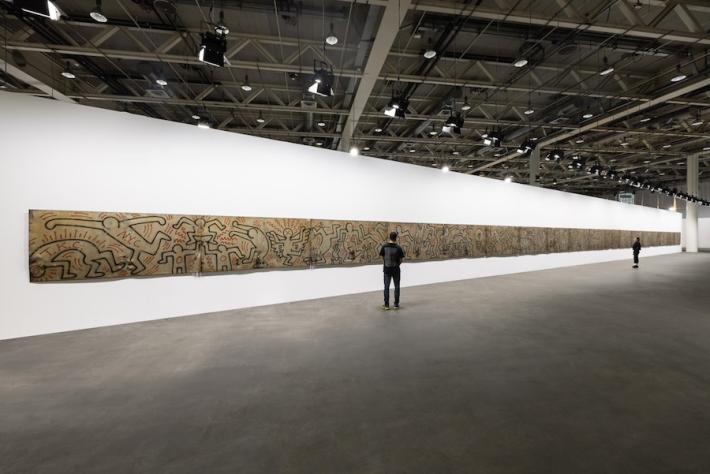
One of the world’s most famous street artists, Keith Haring was just gaining international popularity when he painted a nearly 300-foot mural with dancing figures and barking dogs along New York’s Franklin D. Roosevelt East River Drive in 1984.
Spray-painted in situ on metal panels that formed a fence between Asphalt Green Park and the congested highway, the endlessly long work consisted of black outlined characters animated by red lines to suggest a sense of the figures’ lively movements and energetic auras.
On view for almost a year before the individual panels were taken down in 1985 and subsequently dispersed, parts of the mural have since been exhibited in shows around the world.
Though, this is the first time that such a large section of the painting (18 individual panels displayed in Unlimited) have been seen since their creation and initial display— making it a once in a lifetime opportunity to see an iconic artwork from the heyday of New York’s graffiti art scene, 40 years ago.
Image: Installation view, Keith Haring, Untitled (FDR NY) No. 5-22, 1984.
Paul Laster
Paul Laster is a writer, editor, curator, advisor, artist, and lecturer. New York Desk Editor for ArtAsiaPacific, Laster is also a Contributing Editor at Raw Vision and Whitehot Magazine of Contemporary Art and a contributing writer for Art & Object, Ocula, Galerie, Artsy, Sculpture, Time Out New York, Conceptual Fine Arts, and Two Coats of Paint. Formerly the Founding Editor of Artkrush, he began The Daily Beast’s art section and was Art Editor at Russell Simmons’ OneWorld Magazine. Laster has also been the Curatorial Advisor for Intersect Art & Design and an Adjunct Curator at P.S.1 Contemporary Art Center, now MoMA PS1.























